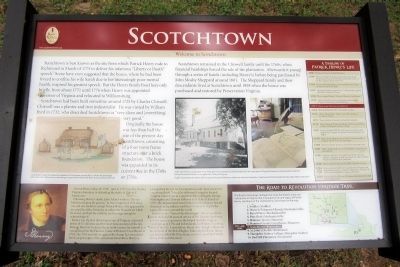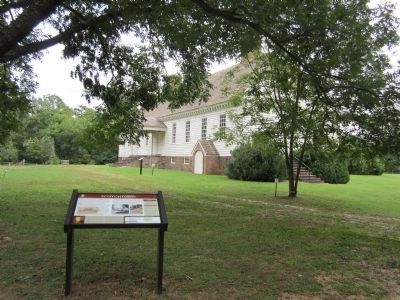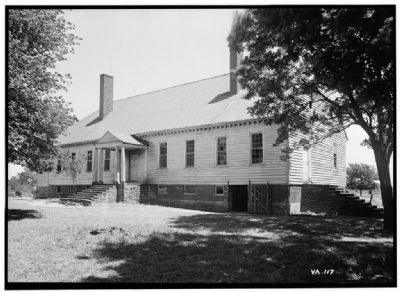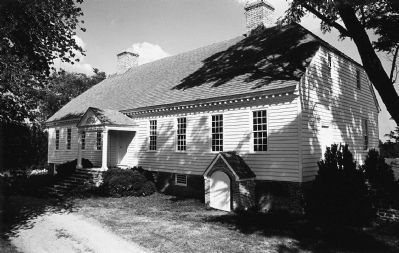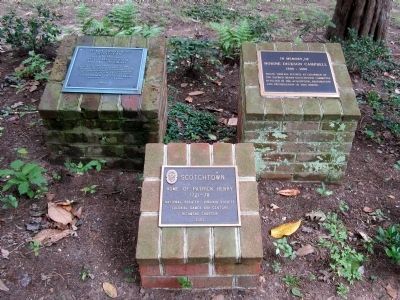Beaverdam in Hanover County, Virginia — The American South (Mid-Atlantic)
Scotchtown
Welcome to Scotchtown
Scotchtown had been built sometime around 1725 by Charles Chiswell. Chiswell was a planter and iron industrialist. He was visited by William Byrd in 1732, who described Scotchtown as “very clean and [everything] very good.”
Originally, the house was less than half the size of the present-day Scotchtown, consisting of a four room frame structure over a brick foundation. The house was expanded to its current size in the 1740s or 1750s.
Scotchtown remained in the Chiswell family until the 1760s, when financial hardships forced the sale of the plantation. Afterwards it passed through a series of hands (including Henry’s) before being purchased by John Mosby Sheppard around 1801. The Sheppard family and their descendants lived at Scotchtown until 1958 when the house was purchased and restored by Preservation Virginia.
(sidebar)
Patrick Henry (May 29, 1736 – June 6, 1799) was the leading Virginia statesman in defending the rights of Colonial America.
Following Henry's death, John Adams wrote to Thomas Jefferson singing his praises: “In the Congress of 1774 there was not one member, except Patrick Henry, who appeared to me sensible of the Precipice or rather the Pinnacle on which he stood, and had the candour and courage enough to acknowledge it.”
Henry was the first elected governor of Virginia, a devoted father of 17 children, and the most famous orator of his day. Born in Hanover County, Henry made a name for himself as a young lawyer in the Parsons’ Cause at Hanover Courthouse in 1763. His 1765 resolutions against the Stamp Act articulated the basic principles of the American Revolution. Henry is perhaps best known for his immortal words “Give me liberty or give me death,” which he delivered during the Second Virginia Convention in a speech to fellow delegates George Washington and Thomas Jefferson at St. John’s Church in 1775. His impassioned words helped move colonists toward American independence and they continue to inspire the cause of freedom around the world.
Known as the “Voice of the Revolution,” Henry’s political career included 26 years of service in the Virginia legislature and five terms as governor. He helped draft
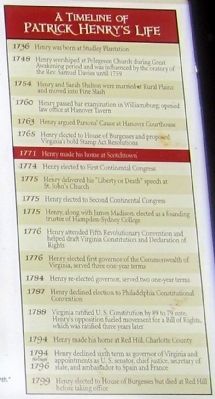
Photographed By Bernard Fisher, September 18, 2011
2. A Timeline of Patrick Henry’s Life
1736 Henry was born at Studley Plantation
1748 Henry worshipped at Polegreen Church during Great Awakening period and was influenced by the oratory of the Rev. Samuel Davies until 1759
1754 Henry and Sarah Shelton were married at Rural Plains and moved into Pine Slash
1760 Henry passed bar examination in Williamsburg; opened law office at Hanover Tavern
1763 Henry argued Parsons’ Cause at Hanover Courthouse
1765 Henry elected to House of Burgesses and proposed Virginia’s bold Stamp Act Resolutions
1771 Henry made his home at Scotchtown
1774 Henry elected to First Continental Congress
1775 Henry delivered his “Liberty or Death” speech at St. Johns Church
1775 Henry elected to Second Continental Congress
1775 Henry, along with James Madison, elected as a founding trustee of Hampden-Sydney College
1776 Henry attended Fifth Revolutionary Convention and helped draft Virginia Constitution and Declaration of Rights
1776 Henry elected first governor of the Commonwealth of Virginia, served three one-year terms
1784 Henry re-elected governor, served two one-year terms
1787 Henry declined election to Philadelphia Constitutional Convention
1788 Virginia ratified U.S. Constitution by 89 to 79 vote, Henry’s opposition fueled movement for a Bill of Rights, which was ratified three years later
1794 Henry made his home at Red Hill, Charlotte County
1794 through 1796 Henry declined sixth term as governor of Virginia and appointments as U.S. senator, chief justice, secretary of state, and ambassador to Spain and France
1799 Henry elected to House of Burgesses but died at Red Hill before taking office
1748 Henry worshipped at Polegreen Church during Great Awakening period and was influenced by the oratory of the Rev. Samuel Davies until 1759
1754 Henry and Sarah Shelton were married at Rural Plains and moved into Pine Slash
1760 Henry passed bar examination in Williamsburg; opened law office at Hanover Tavern
1763 Henry argued Parsons’ Cause at Hanover Courthouse
1765 Henry elected to House of Burgesses and proposed Virginia’s bold Stamp Act Resolutions
1771 Henry made his home at Scotchtown
1774 Henry elected to First Continental Congress
1775 Henry delivered his “Liberty or Death” speech at St. Johns Church
1775 Henry elected to Second Continental Congress
1775 Henry, along with James Madison, elected as a founding trustee of Hampden-Sydney College
1776 Henry attended Fifth Revolutionary Convention and helped draft Virginia Constitution and Declaration of Rights
1776 Henry elected first governor of the Commonwealth of Virginia, served three one-year terms
1784 Henry re-elected governor, served two one-year terms
1787 Henry declined election to Philadelphia Constitutional Convention
1788 Virginia ratified U.S. Constitution by 89 to 79 vote, Henry’s opposition fueled movement for a Bill of Rights, which was ratified three years later
1794 Henry made his home at Red Hill, Charlotte County
1794 through 1796 Henry declined sixth term as governor of Virginia and appointments as U.S. senator, chief justice, secretary of state, and ambassador to Spain and France
1799 Henry elected to House of Burgesses but died at Red Hill before taking office
Erected 2011 by The Road to Revolution Heritage Trail. (Marker Number 7.)
Topics and series. This historical marker is listed in this topic list: Notable Buildings. In addition, it is included in the Former U.S. Presidents: #03 Thomas Jefferson series list. A significant historical month for this entry is March 1775.
Location. 37° 50.667′ N, 77° 35.191′ W. Marker is in Beaverdam, Virginia, in Hanover County. Marker can be reached from Chiswell Lane (Virginia Route 740) 0.1 miles north of Scotchtown Road (Virginia Route 685). Touch for map. Marker is at or near this postal address: 16120 Chiswell Lane, Beaverdam VA 23015, United States of America. Touch for directions.
Other nearby markers. At least 8 other markers are within 6 miles of this marker, measured as the crow flies. A different marker also named Scotchtown (approx. 1.4 miles away); Cedar Creek Quaker Meeting House (approx. 2.7 miles away); Fork Church (approx. 3.1 miles away); Church Quarter (approx. 3.3 miles away); Attack at Ox Ford (approx. 5 miles
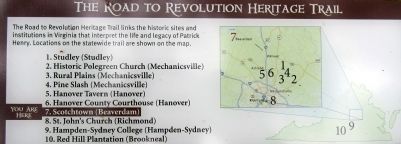
Photographed By Bernard Fisher, September 18, 2011
3. The Road to Revolution Heritage Trail
The Road to Revolution Heritage Trail links the historic sites and institutions in Virginia that interpret the life and legacy of Patrick Henry. Locations on the statewide trail are shown on the map.
1. Studley (Studley)
2. Historic Polegreen Church (Mechanicsville)
3. Rural Plains (Mechanicsville)
4. Pine Slash (Mechanicsville)
5. Hanover Tavern (Hanover)
6. Hanover County Courthouse (Hanover)
7. Scotchtown (Beaverdam)
8. St. John’s Church (Richmond)
9. Hampden-Sydney College (Hampden-Sydney)
10. Red Hill Plantation (Brookneal)
1. Studley (Studley)
2. Historic Polegreen Church (Mechanicsville)
3. Rural Plains (Mechanicsville)
4. Pine Slash (Mechanicsville)
5. Hanover Tavern (Hanover)
6. Hanover County Courthouse (Hanover)
7. Scotchtown (Beaverdam)
8. St. John’s Church (Richmond)
9. Hampden-Sydney College (Hampden-Sydney)
10. Red Hill Plantation (Brookneal)
More about this marker. Photo captions:
J.D.G. Brown made this watercolor drawing of Scotchtown around 1820. It shows the plantation with some of its 19th century outbuildings, many of which have now been reconstructed on the site.
[left] Scotchtown as it appeared in the 1930s, prior to its restoration by the Association for the Preservation of Virginia Antiquities (now Preservation Virginia). Historic American Buildings Survey Collection, Library of Congress
[right] Scotchtown was Patrick Henry’s home during the volatile years before the American Revolution. It was here that he formulated his ideas about “liberty and death.”
Also see . . . Scotchtown (pdf file). National Register of Historic Places (Submitted on September 22, 2011, by Bernard Fisher of Richmond, Virginia.)
Credits. This page was last revised on August 18, 2017. It was originally submitted on September 22, 2011, by Bernard Fisher of Richmond, Virginia. This page has been viewed 971 times since then and 33 times this year. Photos: 1, 2, 3, 4. submitted on September 22, 2011, by Bernard Fisher of Richmond, Virginia. 5. submitted on August 25, 2009, by Bernard Fisher of Richmond, Virginia. 6, 7. submitted on September 22, 2011, by Bernard Fisher of Richmond, Virginia.
